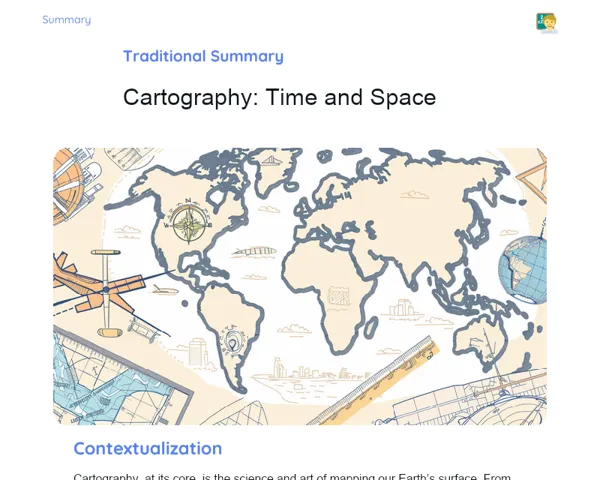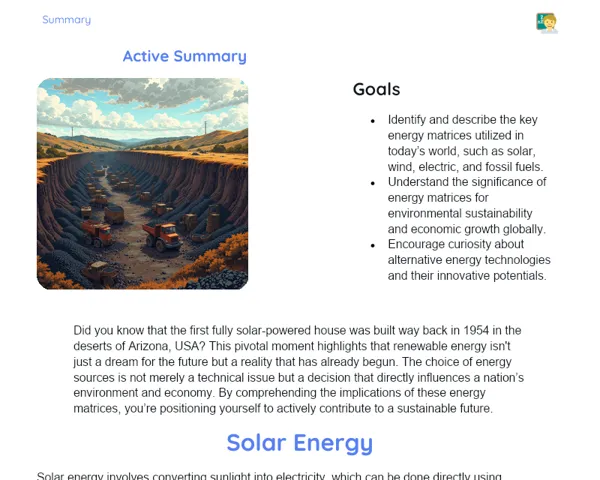Summary Tradisional | Europe: Natural Aspects
Contextualization
Europe is a continent known for its rich geographical diversity, featuring a mix of landscapes from expansive plains to majestic mountain ranges. This variety stems from intricate geological processes that have taken place over millions of years. Understanding the natural features of Europe, such as its relief, hydrography, and climate, is crucial for appreciating not only the continent's physical geography but also its historical, economic, and cultural contexts.
The European relief largely consists of low-lying areas, with extensive plains that support agriculture and human settlements. Key examples are the Eastern European Plain, the Central European Plain, and the Western European Plain. Conversely, mountain ranges like the Alps, Pyrenees, and Carpathians play significant roles in influencing the climate and economy of their respective regions. Furthermore, natural landmarks such as the Ural Mountains and rivers like the Danube and Rhine are vital in delineating political and cultural boundaries in Europe, showcasing the deep connection between physical geography and human activity.
To Remember!
European Relief
The relief of Europe is primarily flat, with vast plains covering a significant portion of the continent. Notable plains include the Eastern European Plain, the Central European Plain, and the Western European Plain. These plains are known for their fertile soils, which support extensive agriculture and human settlements. The Eastern European Plain is the largest and most continuous, stretching for many kilometers, while the Central and Western plains are smaller and more fragmented.
These plains have historically been crucial for Europe, facilitating the movement of populations and goods over time. Additionally, the flat topography has fostered the growth of large urban centers and transportation networks, including roads and railways. Intensive agriculture thrives in these regions, with grains, fruits, and vegetables being the primary products.
The economic significance of these plains cannot be understated. They support high population densities and serve as the backbone of the continent's agricultural production. The combination of rich soils, favorable climate, and advanced farming techniques has allowed these areas to achieve efficient food production, which is essential for Europe's food security.
-
Europe has extensive plains, such as the Eastern, Central, and Western European Plains.
-
The fertile soils of these plains support agriculture and human habitation.
-
These areas are key for trade, urban development, and infrastructure growth.
Mountain Ranges
Europe's mountain ranges are notable geological features that significantly impact the climate and economy of their regions. The renowned Alps stretch across several countries, including France, Switzerland, Italy, and Austria, and are famous for their ski resorts and appeal as year-round tourist destinations. The Pyrenees, located between Spain and France, along with the Carpathians, which span Slovakia, Poland, Ukraine, and Romania, are also prominent mountain ranges in Europe.
The formation of these ranges is attributed to complex tectonic activities, especially the collision between the African and Eurasian tectonic plates. These geological events not only formed towering mountains but also shaped the climate of adjacent areas by affecting air currents and forming distinctive microclimates. For instance, the Alps serve as a barrier that separates the Mediterranean climate of Southern Europe from the temperate climate found in the North.
In addition to being tourist hotspots, mountain ranges are vital sources of natural resources like minerals and freshwater. They also play a significant role in generating hydropower using the rivers that cascade down from the heights. The biodiversity in these mountainous regions is remarkable, with many plant and animal species adapting uniquely to their specific environments.
-
The Alps, Pyrenees, and Carpathians are key mountain ranges in Europe.
-
These mountains, formed through tectonic activity, affect local climates and create unique environments.
-
They are vital for tourism, resource extraction, energy generation, and biodiversity.
Natural Boundaries
Natural boundaries significantly influence the political and cultural landscape of Europe. The Ural Mountains, for instance, mark the traditional border between Europe and Asia, stretching from the Caspian Sea all the way to the Arctic Ocean. This natural barrier has long been seen as the division between the two continents, shaping the geographical and cultural identity of nearby areas.
Rivers also serve as important natural boundaries across Europe. The Danube River, which flows through ten nations and empties into the Black Sea, is one of the most prominent. It functions not only as a physical divider but also as a critical transportation and trade corridor. Similarly, the Rhine River, which originates in the Swiss Alps and flows into the North Sea, is another significant waterway that delineates boundaries and facilitates trade among European countries.
These natural barriers deeply impact the political and cultural divisions in Europe. They contribute to the formation of states and regions by outlining territories and enriching the continent's cultural and linguistic variety. Furthermore, rivers like the Danube and Rhine have witnessed numerous historical milestones and continue to hold significance in the economic and political interactions among European nations.
-
The Ural Mountains serve as the border between Europe and Asia.
-
The Danube and Rhine Rivers exemplify important natural boundaries.
-
These boundaries shape political and cultural divisions while also aiding trade and travel.
Hydrography
Europe's hydrography is intricate and diverse, marked by a complex network of rivers and lakes that play essential roles in the economy, transport, and ecology of the region. The Volga River, the continent's longest river, flows through Russia and discharges into the Caspian Sea. This river is crucial for moving goods and people and is also a vital source of water for agricultural irrigation and industry.
Another key river is the Danube, which is the second longest and runs through ten countries, linking various cultures and economies before emptying into the Black Sea. The Rhine River holds historical and economic significance as a major navigation route in Western Europe, facilitating trade among Germany, France, and the Netherlands.
European lakes like Lake Ladoga, the largest in Europe situated in Russia, are also noteworthy. These water bodies not only provide drinking water and fishing opportunities but also play vital roles in regulating local climates and preserving biodiversity. Overall, Europe’s hydrography is crucial for sustaining both aquatic and land ecosystems, reflecting the interconnectedness of water resources and human life.
-
Europe's hydrography includes an extensive network of rivers and lakes.
-
The Volga River, the largest, is essential for transport and irrigation.
-
Lakes like Lake Ladoga contribute to water supply, fishing, and biodiversity.
Climate and Vegetation
Europe showcases remarkable climate diversity, ranging from the Mediterranean conditions in the south to polar climates in the north. The Mediterranean climate, prevalent in countries like Spain, Italy, and Greece, features hot, dry summers and mild, wet winters, making it ideal for growing crops like olives and grapes. In contrast, the polar climate found in regions such as Scandinavia and Arctic Russia experiences long, harsh winters and brief, cool summers.
The continental relief, marked by mountains and plains, also impacts climate. Mountain ranges like the Alps can obstruct air masses, resulting in unique microclimates in surrounding areas. Moreover, the proximity to major water bodies, like the Atlantic Ocean and the Mediterranean Sea, further influences climate by providing moisture and moderating temperature extremes.
Vegetation across Europe is just as varied, mirroring the continent's climate diversity. Temperate deciduous and coniferous forests are widespread in Central and Eastern Europe, while the northernmost areas are characterized by tundras and taigas. In the southern regions, Mediterranean vegetation, with resilient shrubs and trees adapted to dry conditions, is dominant. This broad range of vegetation supports rich biodiversity and is vital for the conservation of natural ecosystems.
-
Europe's climate varies from Mediterranean to polar.
-
Geographical relief and proximity to large water bodies significantly affect climate conditions.
-
Vegetation ranges from temperate forests to tundras, reflecting climatic diversity.
Key Terms
-
European Relief: Largely flat plains conducive to agriculture and habitation.
-
Mountain Ranges: The Alps, Pyrenees, and Carpathians are essential in influencing climate and hold economic significance.
-
Natural Boundaries: The Ural Mountains, Danube, and Rhine Rivers impact political and cultural delineations.
-
Hydrography: Includes rivers like the Volga and lakes like Ladoga, critical for transport, irrigation, and biodiversity.
-
Climate and Vegetation: From Mediterranean to polar climates, featuring diverse vegetation types like temperate forests and tundras.
Important Conclusions
In this lesson, we examined the primary physical characteristics of Europe, including its low-lying relief with extensive plains that support agriculture and settlements. We also highlighted mountain ranges like the Alps and the Pyrenees, which significantly influence the climate and economies of neighboring regions, as well as their importance in tourism and biodiversity. Additionally, we discussed natural boundaries, such as the Ural Mountains and the Danube and Rhine Rivers, that play a significant role in the continent's political and cultural divisions.
The hydrography of Europe was another critical aspect, characterized by a network of rivers and lakes vital for transportation, irrigation, and ecological health. Rivers like the Volga and Danube were emphasized for their economic and ecological relevance. Lastly, we touched upon Europe’s climate diversity, which ranges from Mediterranean to polar, affecting vegetation from temperate forests to drought-resistant Mediterranean flora.
Understanding these natural elements is key to comprehending Europe’s history, economy, and culture. The insights gained from this lesson will allow for a greater understanding of how physical environments interact with human factors, stressing the importance of geography in shaping cultural identities and societal development. We encourage students to further delve into these topics for a more comprehensive grasp of the European continent.
Study Tips
-
Review physical maps of Europe to visualize the discussed plains, mountain ranges, and natural boundaries.
-
Research the geological formation of the main mountain ranges and their influence on regional climates and economies.
-
Explore articles or documentaries on European hydrography and the role of rivers and lakes in transport, irrigation, and biodiversity conservation.



